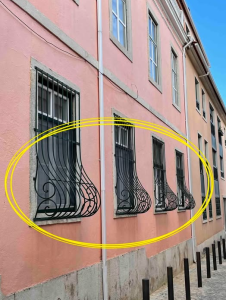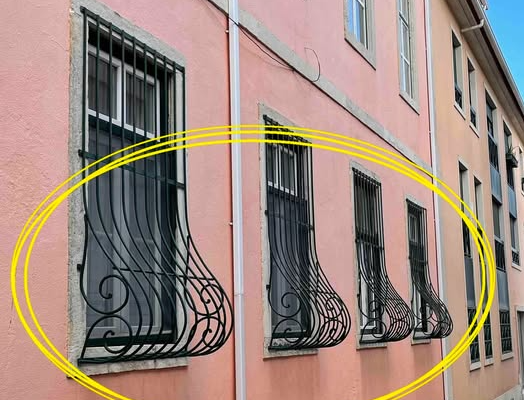The Curve Beneath the Glass: A Story of Form, Function, and Quiet Grace
In the quiet alleys of old cities, where wrought iron whispers stories of centuries past, you might notice a peculiar detail: window grills that curve outward at the bottom, forming a gentle belly beneath the pane. They’re not just decorative. They’re not just practical. They’re a quiet testament to the way beauty and necessity can coexist—and sometimes, even protect.
These curved grills, often called “potbelly bars” or “belly grills,” are more than architectural quirks. They are born from a confluence of safety, style, and human need. Their origins trace back to urban centers where space was precious, and windows served as more than just portals to light—they were lifelines to the outside world.
Aesthetic Intentions and the Language of Iron
Let’s begin with the obvious: they’re beautiful. The curve softens the rigidity of iron, giving the window a kind of grace—a bow, a gesture. In historic towns like Charleston or Barcelona, these curves often cradle flower boxes, turning the façade into a living canvas. The iron, once forged for defense, now holds blooms. It’s a transformation from barrier to cradle.
But this aesthetic choice is not frivolous. It’s deeply intentional. In cultures where the home’s exterior reflects pride and personality, the curved grill becomes a signature. It says: “We care about beauty, even in our defenses.”
Safety, Reimagined
The practical roots of the curve are grounded in safety. Straight bars may seem more secure, but the curve offers a buffer zone—a space between the window and the grill that serves multiple purposes. For one, it allows residents to lean out safely, to call to a neighbor, to watch children play below, or to feel the breeze without risking a fall.
In high-rise buildings, this design can be lifesaving. The outward bulge prevents direct vertical access, making it harder for someone to climb or fall through. It’s a subtle but powerful reimagining of what protection looks like—not just keeping danger out, but allowing life to flow safely within.
A Place for Life to Grow
One of the most charming uses of the curved grill is its role as a planter holder. In cities where balconies are rare and gardens are dreams, the window becomes a sanctuary. The curve cradles flower boxes, herbs, even small vegetables. It’s a space reclaimed for life.
This design choice reflects a deeper human impulse: to cultivate beauty, even in constraint. The grill becomes a metaphor for resilience. Within the confines of iron and concrete, something green dares to grow.
Adaptation to Architecture
There’s also a mechanical logic to the curve. In buildings with tilting windows—those that open outward from the bottom—the curve provides clearance. Without it, the window might hit the bars, rendering it useless. The belly of the grill accommodates the movement, allowing air and light to enter freely.
This is where form meets function in its purest sense. The curve isn’t just an aesthetic flourish—it’s a solution. It’s a way to preserve the integrity of the window while maintaining security.
Cultural Echoes and Symbolism
In some cultures, the curve carries symbolic weight. It’s seen as a gesture of openness, a softening of the home’s exterior. In others, it’s a nod to tradition—an echo of colonial design, where ironwork was both protective and ornamental.
There’s also a psychological element. Straight bars can feel prison-like, evoking confinement. The curve, by contrast, feels generous. It suggests that protection need not be harsh. That safety can be beautiful.
The Curve as a Social Connector
In tightly packed neighborhoods, windows are social spaces. They’re where conversations happen, where children wave to grandparents, where vendors call out their wares. The curved grill facilitates this. It allows people to lean out, to engage, to be part of the street’s rhythm.
It’s a small architectural detail with a big social impact. It turns the window into a stage, a perch, a place of connection.
Modern Interpretations and Revival
Today, as urban design trends shift toward minimalism, the curved grill is sometimes dismissed as outdated. But in many places, it’s making a quiet comeback. Designers are rediscovering its charm, its utility, its ability to blend security with style.
In modern homes, the curve might be sleeker, more geometric. But the essence remains: a space that protects, supports, and beautifies.
A Symbol of Duality
Ultimately, the curved window grill is a symbol of duality. It’s strong yet soft, protective yet inviting. It holds back danger while cradling life. It’s a reminder that design can be both functional and poetic.
In a world that often divides utility from beauty, the curve beneath the window stands as a quiet rebellion. It says: we can have both. We can be safe and still reach out. We can be secure and still grow flowers.
Conclusion: The Curve That Speaks
So the next time you walk past a window with a curved grill, pause. Look closer. You’re not just seeing iron—you’re seeing intention. You’re seeing a design that has evolved through centuries of human need, creativity, and care.
It’s a curve that speaks. Of safety. Of beauty. Of life leaning out toward the world.


